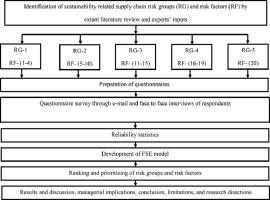Resources, Conservation and Recycling ( IF 11.2 ) Pub Date : 2021-10-20 , DOI: 10.1016/j.resconrec.2021.105975 Shahriar Raian 1 , Syed Mithun Ali 1 , Md. Rayhan Sarker 1 , Bathrinath Sankaranarayanan 2 , Golam Kabir 3 , Sanjoy Kumar Paul 4 , Ripon Kumar Chakrabortty 5

|
Today, sustainability has gained significant importance in supply chain management due to its strategic business advantages. Concurrently, industries are facing supply chain sustainability risks emanated from diversified sources. So far, however, literature is scarce regarding sustainability risk assessment. To fill this research gap, this paper presents a real-life case study of the textile industry to identify and quantify supply chain sustainability risks. In this paper, the fuzzy synthetic evaluation method is applied to compute the likelihood of occurrence, amount of impact, risk criticality of each risk factor group, and the total risk. This study finds five risk groups along with twenty sustainability risk factors. The risk groups are listed as ‘supplier’, ‘financial’, ‘social’, ‘transportation’, and ‘environmental’, based on their respective risk criticality values. The top three sustainability risk factors are ‘poor product transportation system’, ‘air, water, and soil pollution’, and ‘factory fire’. The overall risk criticality value of sustainability risks of the case industry is found as approximately high. An objective of this study is to guide practitioners to take the required strategic steps to assess and manage sustainability risks in their supply chains.
中文翻译:

不确定性下纺织行业供应链可持续性风险评估
如今,可持续发展因其战略业务优势而在供应链管理中变得越来越重要。同时,各行业正面临来自多元化来源的供应链可持续性风险。然而,到目前为止,关于可持续性风险评估的文献很少。为了填补这一研究空白,本文提出了纺织行业的真实案例研究,以识别和量化供应链可持续性风险。本文采用模糊综合评价方法计算各风险因素组的发生可能性、影响量、风险临界度和总风险。该研究发现了五个风险组以及二十个可持续性风险因素。风险组被列为“供应商”、“财务”、“社会”、“运输”和“环境”,基于它们各自的风险临界值。排名前三的可持续性风险因素是“产品运输系统差”、“空气、水和土壤污染”和“工厂火灾”。案例行业的可持续性风险的整体风险临界值大约很高。本研究的一个目标是指导从业者采取必要的战略步骤来评估和管理其供应链中的可持续性风险。







































 京公网安备 11010802027423号
京公网安备 11010802027423号